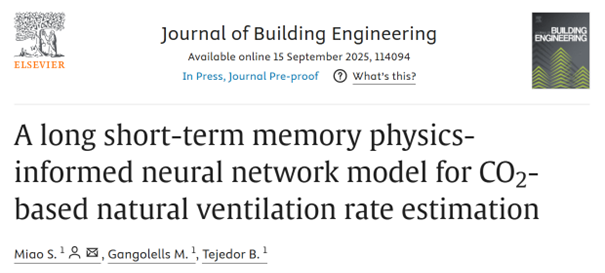The IAQ4EDU project has proposed a novel algorithm “NVR-PINN” for natural ventilation estimation
Sep 19, 2025
The article has been published in the Journal of Building Engineering
The IAQ4EDU project has proposed a novel algorithm called “NVR-PINN” for natural ventilation rate estimation based on CO2 measurement data post-processing. The article has been now published in the top-indexed journal of Journal of Building Engineering (JCR-Q1, Impact Factor: 7.4), is entitled "A long short-term memory physics-informed neural network model for CO2-based natural ventilation rate estimation". Dr. Sen Miao conducted this research during his doctoral thesis research, under the supervision of Prof. Marta Gangolells, principal investigator of the IAQ4EDU project, and Prof. Blanca Tejedor.
The occupant-released CO2 tracer gas approach has been widely used for ventilation rate estimation. However, the CO2 measurement noise and CO2 generation uncertainties can significantly affect the accuracy of the estimated ventilation rates, while the dynamics of the natural ventilation rates could challenge the stability of the estimators. As commonly applied techniques, the moving average filter and the extended Kalman filter have their own advantages and limitations in addressing these issues. To further address the challenges in the natural ventilation rate estimation, this paper proposes a novel model named “NVR-PINN”, based on the long short-term memory-physics-informed neural network and validates it with a case study. The proposed model combines the strengths of the moving average filter and the extended Kalman filter, demonstrating better practical values. It is capable of handling both CO2 measurement noise and CO2 generation uncertainty, effectively capturing the temporal dynamics of the natural ventilation rate, while processing the entire time series observation with a defined sequence window to yield more stable and consistent estimates.

Schematic diagram of proposed NVR-PINN
All details in the online version of the article:
https://doi.org/10.1016/j.jobe.2025.114094
For more information visit our social media pages:
 LinkedIn of the project
LinkedIn of the project  GRIC's Twitter
GRIC's Twitter  ResearchGate
ResearchGate


Share: